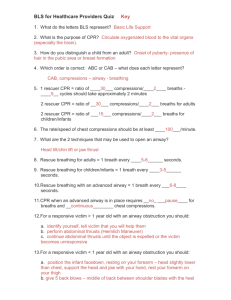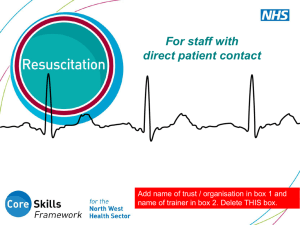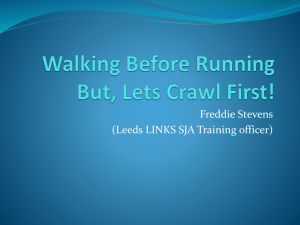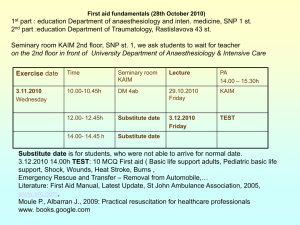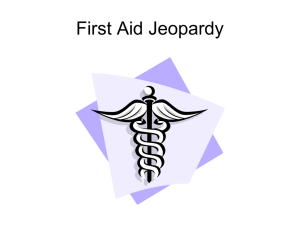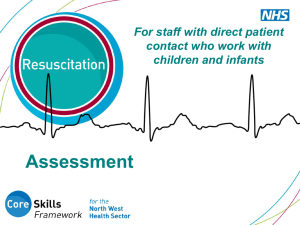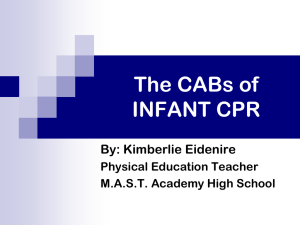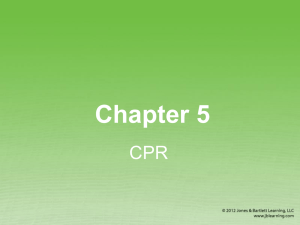Slide 1 - Silver Cross Emergency Medical Services System
advertisement
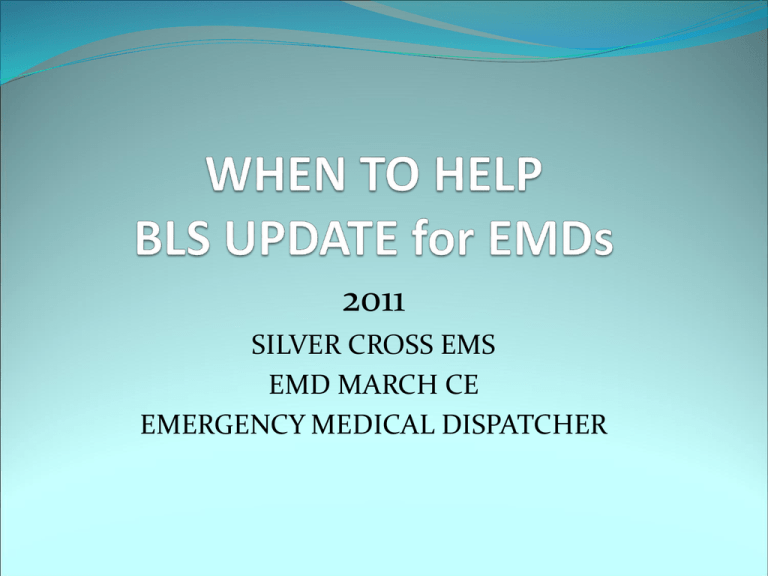
2011 SILVER CROSS EMS EMD MARCH CE EMERGENCY MEDICAL DISPATCHER OBJECTIVES Review background information on BLS Provide information on DOAs Review updated information on CPR for the Adult, Child and Infant victims based on the AHA 2010 Guidelines for Heartsaver Review procedures for assisting victims that are choking Troubleshoot possible complications encountered during BLS When the heart has stopped and the victim is not breathing, CPR is the answer. Without a constant supply of blood, cells of the body will start to die. Brain damage begins within 4 to 6 minutes after cardiac arrest. Within 8 to 10 minutes, the damage may be irreversible. Cardiopulmonary resuscitation will help to circulate oxygenated blood until more advanced medical care can be performed. CPR CPR by itself cannot sustain life indefinitely. It should be started as soon as possible to give the patient the best chance for survival. Many patients will need defibrillation and medication to be successfully resuscitated. It’s all part of the process…………. The Chain of Survival Source: American Heart Association The Chain of Survival The links in the Chain of Survival include: Early recognition of cardiac arrest and activation of the 9-1-1 system Early bystander (or EMD assisted) CPR Early defibrillation by EMRs or other EMS personnel Early advanced care by paramedics and hospital personnel Possible DOA Signs of death Decapitation: The head is separated from the rest of the body. Rigor mortis: Temporary stiffening of muscles occurs several hours after death. Evidence of tissue decomposition: Actual flesh decay occurs only after a person has been dead for more than one day. Dependent lividity: Red or purple color occurs on the parts of the patient’s body that are closest to the ground. When to Start CPR CPR should be started on all non-breathing, pulseless patients, unless they are obviously dead or have a DNR order. (Responders will need to see a valid copy of the order to honor it.) It is better to start CPR on a person that is later declared dead by a physician than to withhold CPR from someone that could have been saved. When in Doubt, Resuscitate! When to Stop CPR (1 of 2) Discontinue CPR only when: Effective spontaneous circulation and ventilation are restored. Resuscitation efforts are transferred to another trained person who continues CPR. A physician orders you to stop. The patient is transferred to properly trained EMS personnel. When to Stop CPR (2 of 2) Discontinue CPR only when: (cont’d) Reliable criteria for death are recognized. You are too exhausted to continue resuscitation, environmental hazards endanger your safety, or continued resuscitation would place the lives of others at risk. It all starts with A-B-C A – Airway B – Breathing NO? C – Circulation START COMPRESSIONS! New Sequence FOLLOW THIS LINK TO WATCH THE NEW GUIDELINES VIDEO http://www.youtube.com/watch? v=O9T25SMyz3A AHA 2010 Recommendations Adult (HS 1 Rescuer) Unresponsive? Call for help & AED Not breathing or only gasping (Agonal breaths) Start compressions in the center of the chest between the nipples, at a rate of 100/min and a depth of at least 2 inches, allowing for chest recoil • 30:2 Ratio of compressions to breaths • After 30 compressions, open the airway with a head tilt-chin lift and deliver 2 breaths • When rescuers are untrained or not proficient, compressions only can be performed • PUSH HARD & FAST AHA 2010 Recommendations Children (HS 1 Rescuer) Unresponsive? Not breathing or only gasping Start compressions in the center of the chest between the nipples, at a rate of at least 100/min and a depth of 2 inches or 1/3 chest diameter, allowing for chest recoil • 30:2 Ratio of compressions to breaths • After 30 compressions, open the airway with a head tiltchin lift and deliver 2 breaths • After 5 cycles or 2 minutes, call for help, continue cycles • When rescuers are untrained or not proficient, compressions only can be performed • PUSH HARD & FAST AHA 2010 Recommendations Infant (HS 1 Rescuer) Unresponsive? Not breathing or only gasping Start compressions in the center of the chest between the nipples, at a rate of at least 100/min and a depth of 1 1/2 inches or 1/3 chest diameter, allowing for chest recoil • 30:2 Ratio of compressions to breaths • After 30 compressions, open the airway with a head tiltchin lift and deliver 2 breaths • After 5 cycles or 2 minutes, call for help, continue cycles • When rescuers are untrained or not proficient, compressions only can be performed • PUSH HARD & FAST GENERAL INFO Make sure victim is on a firm, flat surface Minimize interruptions to chest compressions, 1o seconds or less Watch for chest rise with breaths Attach AED as soon as it is available and follow the prompts Resume compressions immediately after administering a shock 30 compressions should be given over approximately 18 seconds (think of the tune Staying Alive) Recovery Position If the victim is unconscious but breathing: Roll the patient onto one side, as you support the patient’s head. Place the patient’s face on his or her side so any secretions drain out of the mouth and the tongue won’t block the airway. Is It Working? The victim’s color should improve The chest should be rising with each breath The compressions and breaths are delivered at the appropriate rate and depth Possible Complications Broken ribs Check hand placement and continue Gastric Distension (air in the stomach) Can happen if the airway is not open, re-tilt head Make sure breaths are not given too forcefully or too fast, give over 1 second each and allow for exhalation Give breaths only until the chest rises Be alert for vomiting and keep airway clear Chest does not rise Reposition head and try breath again. If it’s still not rising go right to compressions Victim breathes through a stoma (opening in the neck) If the chest does not rise with breaths, cover mouth and nose for possible air leakage Causes of Airway Obstruction The most common airway obstruction is the tongue. If the tongue is blocking the airway, the head tilt–chin lift maneuver performed on the unconscious victim should open the airway. Food is the most common foreign object that causes an airway obstruction. If a foreign body is lodged in the air passage, you must use other techniques to remove it. Are you choking? Mild Obstruction Victim is able to cough or is gagging Victim is able to speak and breath Encourage victim to cough and monitor them in case the airway becomes blocked Severe Obstruction Victim has ineffective cough Victim is unable to speak or breath Victim is displaying the Universal Sign for choking Prepare to help victim Management of Foreign Body Airway Obstructions Airway obstruction in an adult or child If the victim is conscious, stand behind them and perform abdominal thrusts. If the victim is obese or pregnant, stand behind them and perform chest thrusts instead of abdominal thrusts. If the victim becomes unresponsive: Ensure that the EMS system has been activated. Perform CPR, remembering to check the mouth for foreign objects before each breath. Steps for Managing Airway Obstruction in a Conscious Adult or Child 1. Look for signs of choking. 2. Place your fist with the thumb side against the patient’s abdomen, just above the navel. 3. Grasp the fist with your other hand and press into the abdomen with quick inward and upward thrusts. Management of Foreign Body Airway Obstructions (continued) Airway obstruction in an infant Use a combination of 5 back slaps (with the heel of your hand between the shoulder blades) and 5 chest thrusts (with 2 fingers between the nipples on the center of the chest), alternating, until the object is expelled or the victim becomes unconscious. If the infant becomes unresponsive: Ensure that the EMS system has been activated. Begin CPR, remembering to check the mouth for the foreign object before each breath. FYI The flipcharts will be updated to reflect the new changes, in the near future. Until then, use the protocol that you’re currently using. Your current CPR cards are good until the expiration dates printed on the card. Recommended renewal is every 2 years. You previously learned the same skills, the order has just changed to C-A-B. Hands Only CPR will be encouraged for the lay rescuer with no training or is not proficient in the skills For further information on CPR visit the American Heart Association’s website www.heart.org/cpr Resources American Heart Association’s Highlights of the 2010 Guidelines for CPR & ECC and other information provided on their website AAOS Emergency Medical Responder, 5th edition
